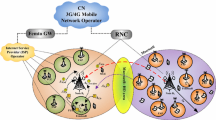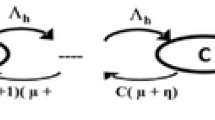Abstract
In cellular networks, forced call terminations due to handoff call blocking are generally more objectionable than new call blocking. In order to maintain an acceptable call dropping probability rate, we propose, in this paper, two new guard channel schemes: an adaptive one – New Adaptive Channel Reservation (NACR) – and a dynamic one – Predictive Reservation Policy (PRP). In NACR, for a given period of time, a given number of channels is guarded in each cell for handoff traffic. In PRP, the number of reserved channels depends on the actual number of calls in progress in the neighboring cells. An approximate analytical model of NACR is presented. A Tabu search method has been implemented in order to optimize the Grade of Service. Discrete event simulations of PRP and NACR were run. The effectiveness of the proposed methods is emphasized on a complex configuration.
Similar content being viewed by others
References
C.A. Anderson, K. Fraugnaugh, M. Parker and J. Ryan, Path assignment for call routing: An application of Tabu search, Annals of Operation Research 41 (1993) 301–312.
S. Boumerdassi, A new reservation and prediction concept in Cellular communication Systems, in: Proc. of IFIP Broadband Communications '98, Stuttgart (April 1998) Chapman & Hall, pp. 157–168.
G.L. Choudury and S.S. Rappaport, Cellular communication schemes using generalized fixed channel assignment and collision type request channels, IEEE Trans. on Vehicular Technology VT-31 (May 1982) 53–65.
J. Daigle and N. Jain, A queuing system with two arrival streams and reserved servers with application to cellular telephone, IEEE Infocom '92 (April 1992) 2161–2167.
F. Glover, Tabu Search Part I, ORSA J. on Computing 1 (1989) 190–206.
R. Guerin, Queueing-blocking system with two arrival streams ans guard channels, IEEE Trans. on Communications 36 (February 1988) 153–163.
D. Hong and S.S. Rappaport, Traffic model and performance analysis for cellular mobile radio telephone systems with prioritized and nonprioritized handoff procedures, IEEE Trans. on Vehicular Technology VT-35 (August 1986) 77–92.
R. Huberman et al., Multihour dimensioning for a dynamically routed network, in: ITC '11, Kyoto, Japan (1985).
D. Raychoudhuri and A.D. Wilson, ATM-based transport architecture for multiservice wireless personal communication networks, IEEE J. on Selected Areas in Communications SAC-12(8) (October 1992).
M. Naghshineh and M. Schwartz, Distributed call admission control in mobile/wireless networks, IEEE J. on Selected Areas in Communications SAC-14 (May 1996) 711–717.
C.H. Yoon and C.K. Un, Performance of personal portable radio telephone systems with and without guard channels, IEEE J. on Selected Areas in Communications 11 (August 1993) 911–917.
O.T.W Yu and V.C.M Leung, Adaptative resource allocation for priotized call admission over an ATM-based wireless PCN, IEEE J. on Selected Areas in Communications SAC-15(7) (September 1997) 1208–1225.
Author information
Authors and Affiliations
Rights and permissions
About this article
Cite this article
Boumerdassi, S., Beylot, A. Adaptive channel allocation for wireless PCN. Mobile Networks and Applications 4, 111–116 (1999). https://doi.org/10.1023/A:1019186412792
Issue Date:
DOI: https://doi.org/10.1023/A:1019186412792




